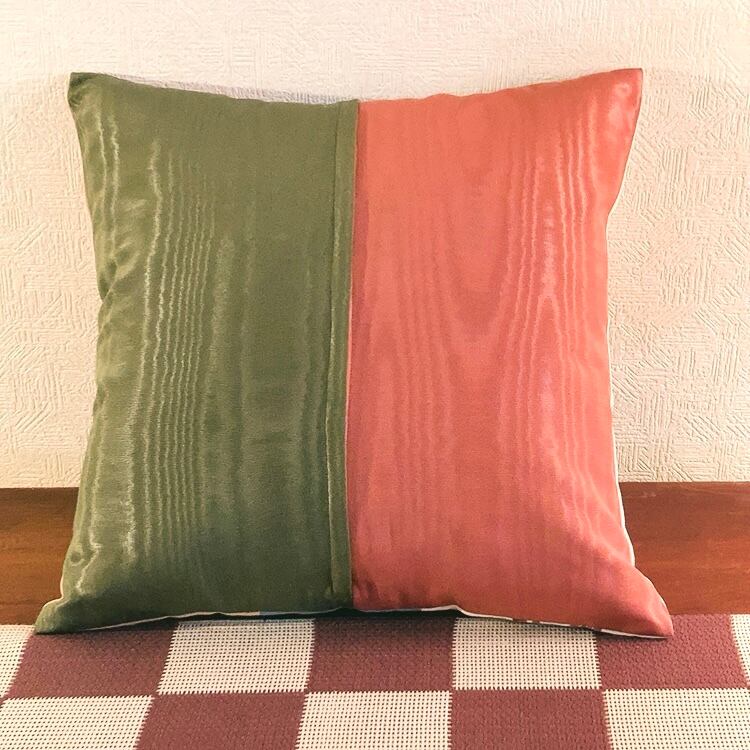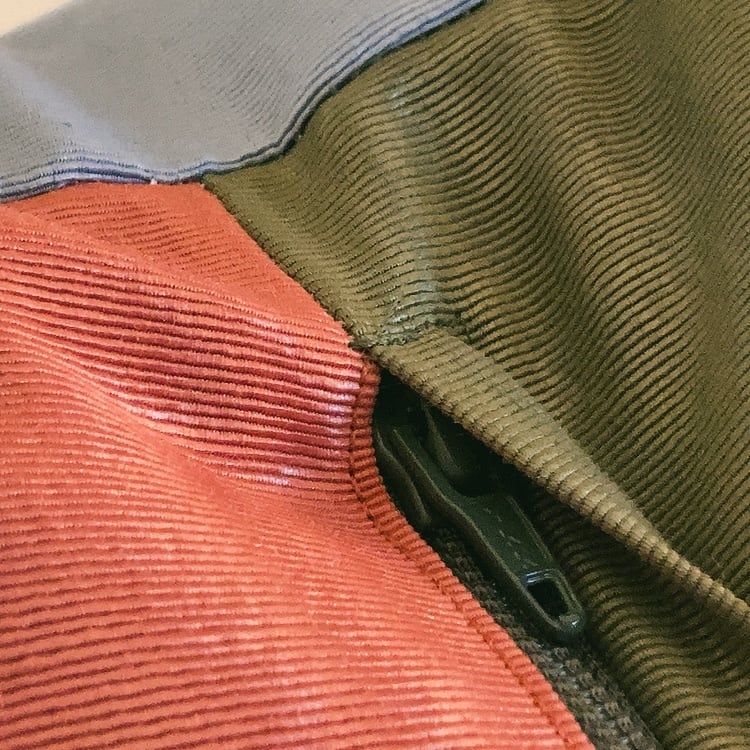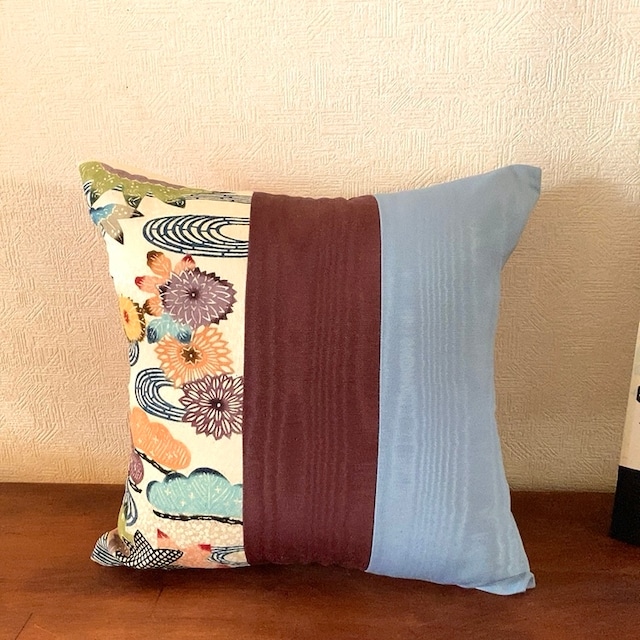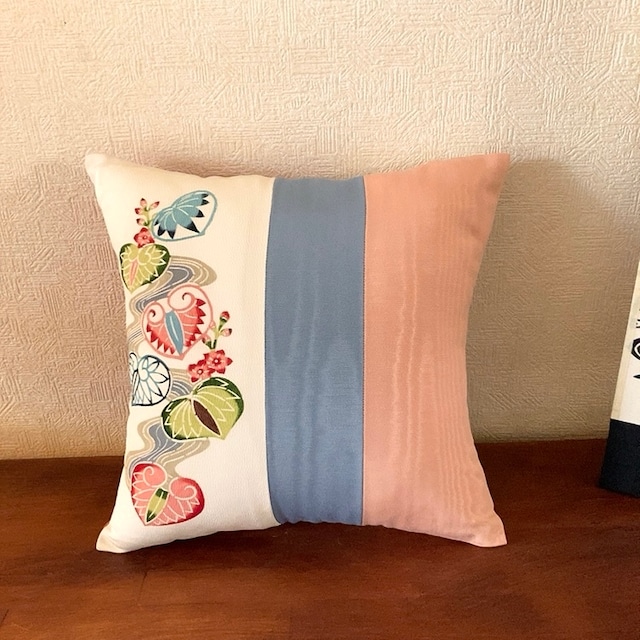5,000円以上のご購入で
送料無料
【モダン紅型】蝶々 (クッションカバー)










5,000円以上のご購入で
送料無料
【モダン紅型】蝶々 (クッションカバー)
【モダン紅型】蝶々 (クッションカバー)
¥14,300
20%OFF
¥11,440
蝶々柄のクッションカバーです。(クッション材なし)
柔らかな雰囲気がお部屋を明るくしてくれる可愛らしいアイテムです。
インテリアのアクセントに使うのもおすすめです。
ソファやベッド周りなどに置くだけでお部屋が華やぎます。
日常生活に染めの彩りを添えてみませんか?
<蝶文>
蝶文が和風化され用いられるようになったのは平安中期以降で、能装束や小袖に意匠されたのは桃山時代からです。好まれた理由の一つとして、姿形の優美さ愛らしさもありますが、その変化の様が呪術的神秘性を感じさせたからとも言われています。不老不死のシンボルとして武士の紋章にも用いられました。
また、蝶は図案家の創造性を刺激して、様々にデザインされ、またアールヌーボー、アールデコなどの時代の影響も色濃く出ています。
--------------------------------------------------------
サイズ:約39cm×約39cm
染色生地:絹
※購入前に必ずご確認下さい※
◆おかめ工房オリジナル商品です。
◆手染めになりますので、一点ものです。
◆染めムラなどある場合がございます。ご了承ください。
※商品の色は、可能な限り実物に近い色を出そうとしておりますが、携帯やパソコン、スマホのモニター環境により若干異なって見える場合がございます。
--------------------------------------------------------
<紅型染め工程>
1.型彫り:デザインを決め、型紙へ転写し、模様部分から彫っていきます。
2.紗張り:型紙を紗という生地で補強、固定する作業です。カシュー液またはペンキを使用します。
3.糊置き:型紙の上からペースト状の防染糊をヘラで薄く均一に伸ばし、生地に模様を写し取っていきます。
4.豆引き:染料が糊の裏側に染み出るのを防ぎ、染料の染め付けを良くし、定着させる作業です。
5.色差し(1度塗り):模様部分(糊がおかれていない部分)を染めていきます。染料・顔料を調整し刷毛で布に刷り込み配色します。顔料は豆汁で溶くと固着剤の役割を果たし、にじみ防止になります。
6.色差し(2度塗り):2回色を刷り込む事で色ムラを無くし、しっかり色を入れます。
7.隈取り:紅型の大きな特徴の一つです。色の上から隈取り用の刷毛で濃い色のぼかしを入れ陰影をつけます。ぼかし染めは図柄にアクセントをつけ立体感を出す効果があります。
8.明礬作業:完全に乾いた後、色落ち止めとして主に明礬を用います。
9.水元:約3日程色を定着させた後、水に浸します。糊が柔らかくなったら、布を斜めに引っ張り糊をはがすように落とします。
10.湯のし:蒸気を使ってシワをきれいに伸ばしていきます。反物幅を均等に揃えるための加工のことです。
11.仕立て:着物や帯、作品に仕立てて完成します。全行程手作業で行っており、全て1点ものとなります。
沢山の工程があり、ひとつひとつ手作業で染色しています。
紅型本来である「顔料」という染料を使い、昔から変わらない工程や技法で本格的な紅型作品を制作しております。
--------------------------------------------------------
Butterfly-patterned cushion cover.
The soft atmosphere of this lovely item will brighten up your room.
We recommend using it as an accent in your interior design.
Just by placing it on the sofa or around the bed, it will brighten up the room.
Why not add a touch of color to your daily life?
<Butterfly pattern>
It was not until the mid-Heian period that the butterfly pattern was stylized into a Japanese design, and it was not until the Momoyama period that it was used on Noh costumes and kosode sleeves. It is said that one of the reasons for the popularity of the butterfly design was not only because of its graceful and lovely shape, but also because the way it changed gave a sense of magical mystique. It was also used as a symbol of immortality in the emblems of warriors.
Butterflies also stimulated the creativity of designers, and were designed in a variety of ways, and were also strongly influenced by the Art Nouveau and Art Deco periods.
--------------------------------------------------------
Size: approx. 39 cm x 39 cm
Dyed fabric: silk
Please be sure to check before purchasing*.
◆Original product of Okame Kobo.
◆This product is hand-dyed, so it is one-of-a-kind.
◆It is hand-dyed and one-of-a-kind. Please understand.
The colors of the products are as close to the real thing as possible, but they may look slightly different depending on the monitor environment of your cell phone, PC, or smartphone.
--------------------------------------------------------
<Bingata Dyeing Process>
1. Kata-bori: The design is decided, transferred to a stencil, and carved starting from the patterned area.
2. Gauze stretching: Reinforcing and fixing the katagami with a fabric called gauze. Cashew solution or paint is used.
3. Glue-placement: Paste paste is spread thinly and evenly over the pattern using a spatula, and the pattern is copied onto the fabric.
4. Mamegaki: This process prevents the dye from seeping through to the underside of the paste, and helps the dye to adhere and fix in place.
5. Color-application (one coat): Dyeing the patterned area (the area not covered with glue). Dye and pigment are adjusted and brushed onto the cloth with a brush to distribute the colors. Dissolving the pigments in soybean juice acts as an adhesive and prevents blotting.
6. Color is applied twice (two coats).
7. Kuma-dori (shading): This is one of the main characteristics of Bingata. The kumadori brush is used to add shades of darker colors on top of the colors. Bokashi-dyeing has the effect of accentuating the design and giving it a three-dimensional effect.
8. Aluminum water: After completely drying, aluminum water is mainly used to prevent the colors from fading.
9. After allowing the colors to set for about three days, soak in water. When the glue softens, pull the cloth at an angle to peel off the glue.
10. Yunoshi: The wrinkles are stretched out cleanly using steam. This process is used to make the width of the fabric even.
11. Tailoring: The fabric is finished by tailoring it into a kimono, obi, or work of art. The entire process is done by hand, and each piece is unique.
There are many processes and each piece is dyed by hand.
We produce authentic Bingata works using dyes called "pigments," which are the original Bingata, and using the same processes and techniques that have been used since ancient times.
柔らかな雰囲気がお部屋を明るくしてくれる可愛らしいアイテムです。
インテリアのアクセントに使うのもおすすめです。
ソファやベッド周りなどに置くだけでお部屋が華やぎます。
日常生活に染めの彩りを添えてみませんか?
<蝶文>
蝶文が和風化され用いられるようになったのは平安中期以降で、能装束や小袖に意匠されたのは桃山時代からです。好まれた理由の一つとして、姿形の優美さ愛らしさもありますが、その変化の様が呪術的神秘性を感じさせたからとも言われています。不老不死のシンボルとして武士の紋章にも用いられました。
また、蝶は図案家の創造性を刺激して、様々にデザインされ、またアールヌーボー、アールデコなどの時代の影響も色濃く出ています。
--------------------------------------------------------
サイズ:約39cm×約39cm
染色生地:絹
※購入前に必ずご確認下さい※
◆おかめ工房オリジナル商品です。
◆手染めになりますので、一点ものです。
◆染めムラなどある場合がございます。ご了承ください。
※商品の色は、可能な限り実物に近い色を出そうとしておりますが、携帯やパソコン、スマホのモニター環境により若干異なって見える場合がございます。
--------------------------------------------------------
<紅型染め工程>
1.型彫り:デザインを決め、型紙へ転写し、模様部分から彫っていきます。
2.紗張り:型紙を紗という生地で補強、固定する作業です。カシュー液またはペンキを使用します。
3.糊置き:型紙の上からペースト状の防染糊をヘラで薄く均一に伸ばし、生地に模様を写し取っていきます。
4.豆引き:染料が糊の裏側に染み出るのを防ぎ、染料の染め付けを良くし、定着させる作業です。
5.色差し(1度塗り):模様部分(糊がおかれていない部分)を染めていきます。染料・顔料を調整し刷毛で布に刷り込み配色します。顔料は豆汁で溶くと固着剤の役割を果たし、にじみ防止になります。
6.色差し(2度塗り):2回色を刷り込む事で色ムラを無くし、しっかり色を入れます。
7.隈取り:紅型の大きな特徴の一つです。色の上から隈取り用の刷毛で濃い色のぼかしを入れ陰影をつけます。ぼかし染めは図柄にアクセントをつけ立体感を出す効果があります。
8.明礬作業:完全に乾いた後、色落ち止めとして主に明礬を用います。
9.水元:約3日程色を定着させた後、水に浸します。糊が柔らかくなったら、布を斜めに引っ張り糊をはがすように落とします。
10.湯のし:蒸気を使ってシワをきれいに伸ばしていきます。反物幅を均等に揃えるための加工のことです。
11.仕立て:着物や帯、作品に仕立てて完成します。全行程手作業で行っており、全て1点ものとなります。
沢山の工程があり、ひとつひとつ手作業で染色しています。
紅型本来である「顔料」という染料を使い、昔から変わらない工程や技法で本格的な紅型作品を制作しております。
--------------------------------------------------------
Butterfly-patterned cushion cover.
The soft atmosphere of this lovely item will brighten up your room.
We recommend using it as an accent in your interior design.
Just by placing it on the sofa or around the bed, it will brighten up the room.
Why not add a touch of color to your daily life?
<Butterfly pattern>
It was not until the mid-Heian period that the butterfly pattern was stylized into a Japanese design, and it was not until the Momoyama period that it was used on Noh costumes and kosode sleeves. It is said that one of the reasons for the popularity of the butterfly design was not only because of its graceful and lovely shape, but also because the way it changed gave a sense of magical mystique. It was also used as a symbol of immortality in the emblems of warriors.
Butterflies also stimulated the creativity of designers, and were designed in a variety of ways, and were also strongly influenced by the Art Nouveau and Art Deco periods.
--------------------------------------------------------
Size: approx. 39 cm x 39 cm
Dyed fabric: silk
Please be sure to check before purchasing*.
◆Original product of Okame Kobo.
◆This product is hand-dyed, so it is one-of-a-kind.
◆It is hand-dyed and one-of-a-kind. Please understand.
The colors of the products are as close to the real thing as possible, but they may look slightly different depending on the monitor environment of your cell phone, PC, or smartphone.
--------------------------------------------------------
<Bingata Dyeing Process>
1. Kata-bori: The design is decided, transferred to a stencil, and carved starting from the patterned area.
2. Gauze stretching: Reinforcing and fixing the katagami with a fabric called gauze. Cashew solution or paint is used.
3. Glue-placement: Paste paste is spread thinly and evenly over the pattern using a spatula, and the pattern is copied onto the fabric.
4. Mamegaki: This process prevents the dye from seeping through to the underside of the paste, and helps the dye to adhere and fix in place.
5. Color-application (one coat): Dyeing the patterned area (the area not covered with glue). Dye and pigment are adjusted and brushed onto the cloth with a brush to distribute the colors. Dissolving the pigments in soybean juice acts as an adhesive and prevents blotting.
6. Color is applied twice (two coats).
7. Kuma-dori (shading): This is one of the main characteristics of Bingata. The kumadori brush is used to add shades of darker colors on top of the colors. Bokashi-dyeing has the effect of accentuating the design and giving it a three-dimensional effect.
8. Aluminum water: After completely drying, aluminum water is mainly used to prevent the colors from fading.
9. After allowing the colors to set for about three days, soak in water. When the glue softens, pull the cloth at an angle to peel off the glue.
10. Yunoshi: The wrinkles are stretched out cleanly using steam. This process is used to make the width of the fabric even.
11. Tailoring: The fabric is finished by tailoring it into a kimono, obi, or work of art. The entire process is done by hand, and each piece is unique.
There are many processes and each piece is dyed by hand.
We produce authentic Bingata works using dyes called "pigments," which are the original Bingata, and using the same processes and techniques that have been used since ancient times.













